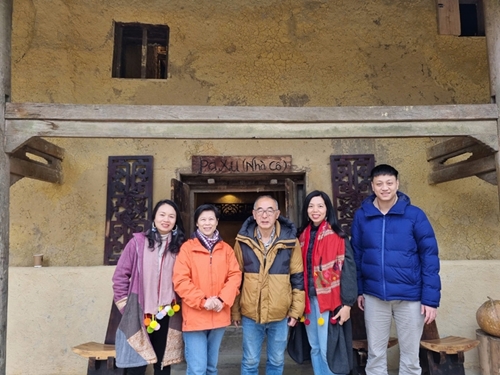Falling in love with the rocky plateau
Visiting Lo Lo Chai village in Lung Cu commune, Dong Van district, Ha Giang province on a freezing day in the Dong Van Karst Plateau, visitors are surprised that the first person to greet them is not a local but a Japanese man, named Yasushi Ogura.
    |
 |
|
Old Ogura and visitors in Lo Lo Chai village |
At 68, Old Ogura remains energetic. In 2024, he traveled between Japan and Vietnam eight times. Each trip followed the same routine: A brief stay in Hanoi before heading to Ha Giang for about two weeks, then returning to Tokyo to care for his mother, who is over 90 years old.
Guiding visitors through Lo Lo Chai like a native tour guide, Old Ogura not only speaks Vietnamese fluently but also understands the Lo Lo people’s spoken language.
At Cuc Bac Café, under a century-old cherry blossom tree, Yasushi Ogura shared his story. Once the director of a food company in Japan, he had traveled to many countries before first visiting Vietnam in 1995.
“I started in Can Tho and visited almost all Vietnamese provinces. In 2002, I set foot in Ha Giang for the first time and fell in love with this land. It felt like finding a missing piece of my soul, so I decided to stay connected, especially with Lo Lo Chai village at the foot of the Lung Cu Flag Tower,” he recalled.
Old Ogura really likes the Northern region of Vietnam, particularly Ha Giang, with its breathtaking karst landscapes and rich cultural heritage. “This land is home to around 20 ethnic groups living together, so many cultural features and traditional customs are still preserved intact and developed to this day, which is very advantageous in tourism development,” he said.
Supporting community-based tourism
Cuc Bac Café has a special corner named “Ogura” in honor of Yasushi Ogura’s contribution. In 2015, after surveying the village, he invested VND 200 million to help Lu Thi Van, a Lo Lo woman from Lo Lo Chai, open a café.
Wanting to preserve the village’s heritage, Old Ogura ensured that the café retained its traditional Lo Lo architecture. He also invited experts from Hanoi to train Van in coffee-making, English, and service for customers. “At first, I found it hard to communicate with her and convince her to open a café. Locals were also unfamiliar with the idea of strangers visiting their houses,” he recalled.
Since 2016, Yasushi Ogura has traveled between Tokyo and Ha Giang almost monthly, spending two weeks exploring villages and promoting local tourism before returning to Japan.
Lu Thi Van recalled: “He loved my old house and offered to help us open a café. At the time, we relied on farming and feared there would not be customers. But thanks to his encouragement and support, we now have a stable income, and enough money for our two children to study at university in Hanoi.”
Therefore, more villagers tried to promote tourism, transforming Lo Lo Chai into a unique community-based tourism destination, now recognized as a provincial three-star OCOP site.
A nonstop journey
The local people’s life has improved, yet his journey of helping the community has not stopped. At Thai Phin Tung and Sang Tung communes, he has wholeheartedly guided locals on tourism, guest services, and hospitality. He has even offered financial support for families to preserve their traditional houses for tourism, alongside State assistance.
For nine years, Old Ogura has tirelessly explored nearly every village in Dong Van and Meo Vac, by motorbike, bicycle, or even trekking long distances. Wherever he goes, villagers warmly welcome the “Japanese old man” as their relative.
Sinh Di Gai, head of Lo Lo Chai village, praised him, “We see him as one of our relatives. Thanks to his efforts, 52 households now run homestays, earning about VND 30 million per month.”
His love for Ha Giang has become a beautiful tale. In recent years, he has also collaborated with Japanese media to promote Ha Giang, attracting even more visitors to Dong Van and Meo Vac.
Translated by Minh Anh